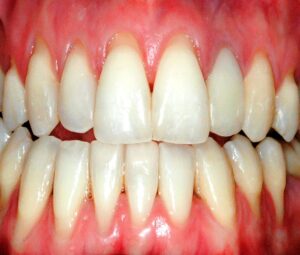What is it?
Gingival recession, also known as receding gums, is a common oral condition characterized by the gradual or localized loss of gum tissue, resulting in exposure of the tooth roots. It can lead to aesthetic concerns, tooth sensitivity, and an increased risk of dental problems such as root caries and tooth root exposure.
Here are some key points about gingival recession:
- Causes of Gingival Recession:
- Periodontal Disease: The most common cause of gingival recession is periodontal disease, particularly gum inflammation (gingivitis) and periodontitis, which can lead to progressive loss of gum tissue and attachment loss.
- Aggressive Tooth Brushing: Overzealous tooth brushing with a hard-bristled toothbrush or improper brushing technique can cause abrasion of the gum tissue and contribute to gingival recession.
- Tooth Malposition: Misalignment or irregular positioning of teeth can create areas of localized pressure or trauma on the gum tissue, leading to recession.
- Tooth Misalignment: Crooked or crowded teeth can create areas where plaque and tartar accumulate more easily, increasing the risk of gum inflammation and recession.
- Trauma: Traumatic injuries to the gums, such as accidental trauma or excessive orthodontic forces, can cause localized gum recession.
- Genetic Factors: Genetic predisposition may play a role in determining an individual’s susceptibility to gingival recession.
- Clinical Presentation:
- Gingival recession is often characterized by the gradual or localized exposure of the tooth roots, which may appear elongated or darker in color compared to the surrounding gums.
- Symptoms may include tooth sensitivity to hot, cold, sweet, or acidic stimuli, particularly in exposed root surfaces.
- Increased susceptibility to root caries (cavities) due to loss of protective gum tissue and exposure of the root surface to oral bacteria.
- Aesthetic concerns, particularly if gingival recession affects the appearance of the smile or results in uneven gum margins.
- Diagnosis:
- Diagnosis of gingival recession involves a comprehensive dental examination, assessment of medical and dental history, and evaluation of clinical signs and symptoms.
- Periodontal probing and measurement of gingival recession depth, attachment loss, and tooth mobility may be performed to determine the severity and extent of recession.
- Treatment:
- Treatment of gingival recession aims to stabilize the condition, reduce further recession, and improve gum health and aesthetics.
- Non-surgical treatments may include:
- Oral hygiene instruction and modification to promote proper tooth brushing and flossing techniques.
- Removal of causative factors such as plaque, tartar, or overhanging dental restorations.
- Periodontal therapy, including scaling and root planing (deep cleaning) to remove plaque and tartar from below the gumline.
- Surgical treatments may include:
- Gum grafting procedures to cover exposed root surfaces and enhance gum tissue thickness and attachment.
- Periodontal plastic surgery techniques such as guided tissue regeneration or connective tissue grafting to enhance gum tissue regeneration and attachment.
- Orthodontic treatment to reposition misaligned or malpositioned teeth and redistribute forces on the gum tissue.
- Prevention:
- Prevention of gingival recession involves maintaining good oral hygiene practices, including regular brushing, flossing, and dental check-ups.
- Avoidance of aggressive tooth brushing, use of a soft-bristled toothbrush, and gentle brushing technique to minimize trauma to the gums.
- Treatment of underlying risk factors such as periodontal disease, tooth misalignment, or malocclusion to prevent further gum recession.
In summary, gingival recession is a common oral condition characterized by the gradual or localized loss of gum tissue, leading to exposure of the tooth roots. It can result from various factors such as periodontal disease, aggressive tooth brushing, tooth malposition, trauma, or genetic predisposition. Diagnosis and treatment of gingival recession require a comprehensive approach to stabilize the condition, address underlying risk factors, and improve gum health and aesthetics. Prevention measures such as proper oral hygiene practices and treatment of underlying risk factors are essential for minimizing the risk of gingival recession and maintaining optimal oral health.

